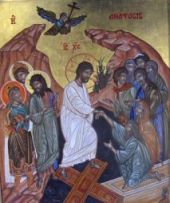I made a rather silly typo in a blog comment yesterday. Or, given that I repeated it twice, perhaps it was more a Freudian slip than a typo. Instead of writing “sola scriptura” I wrote “schola scriptura”. Perhaps I am just an irreformable closet Benedictine after all!
Now, I probably should not have written the comment (or the one that preceded it) in the first place, and I am not going to link to it as it is clear that there is really no room for conversation with the blogger concerned. It’s just that, well, there are certain things that I find really shocking, in this case the idea that Christ did not die for all people, that I felt that I had to say something. But in any case, I should have known better. (Note to self: do not comment on Calvinist blog. In fact, better, do not read Calvinist blogs. Of course the trouble is that, with a few exceptions, most Christian blogs in South Africa seem to be either Calvinist or post-everything, but that is another topic).
But, as I realised that I had written “schola scriptura” instead of “sola scriptura,” it struck me that it was perhaps not such an insignificant difference. For, the school of the Scriptures, with its attitude of sitting at the feet of the biblical authors, and being formed by them, sounds like a far healthier and more traditional attitude to have towards the Scriptures than to see them as a quarry from which to extract arguments with which to defend pre-existing positions. And that reminded me of these words from Father Andrew Louth that I posted over three years ago – how much has happened since then!
The presupposition that lies behind all this – a presupposition either defended (more or less desperately) or finally relinquished – is the principle of sola scriptura, understood as meaning that Scripture is a quarry from which we can extract the truth of God’s revelation: that allied to the more recent notion that the tool to use in extracting meaning from literary texts is the method of historical criticism. We have an alliance between the Reformation and the Enlightenment: not something that inspires confidence. But as will be clear from our considerations so far, both the principle and the method are questionable.
The principle of sola scriptura actually leads one away from the traditional devotion to Scripture as the Word of God which we find par excellence in the Fathers. Scripture is being understood as an arsenal and not as a treasury (to use the contrast drawn by Paul Claudel in his Du sens figure de l’Écriture). And such an understanding leads to a false and misleading notion of the nature of Christianity as a biblical religion. If the bible is seen as a quarry from which truth is to be extracted, then the truth thus extracted – the truth of Christianity – is naturally seen as ‘biblical’. … But as Henri de Lubac protests in his Exégèse Médiévale:
Christianity is not, properly speaking, a ‘religion of the Book’: it is a religion of the word (Parole) – but not uniquely nor principally of the word in written form. It is a religion of the Word (Verbe) – ‘not of a word, written and mute, but of a Word living and incarnate’ (to quote St. Bernard). The Word of God is here and now, amongst us, ‘which we have looked upon, and our hands have handled’: the Word ‘living and active’, unique and personal, uniting and crystallizing all the words which bear it witness. Christianity is not ‘the biblical religion’: it is the religion of Jesus Christ. [Exégèse Médiévale, II/1 (Paris, 1961), pp. 196-9.]
And in those words de Lubac echoes the cry of St. Ignatius of Antioch: ‘For me the archives are Jesus Christ, and the inviolable archives his cross and death and his resurrection and faith in Him.’ [Ep. Philad. VIII. 2.] The heart of Christianity is the mystery of Christ, and the Scriptures are important as they unfold to us that mystery, and not in and for themselves.
Andrew Louth, Discerning the Mystery, 101-102.



